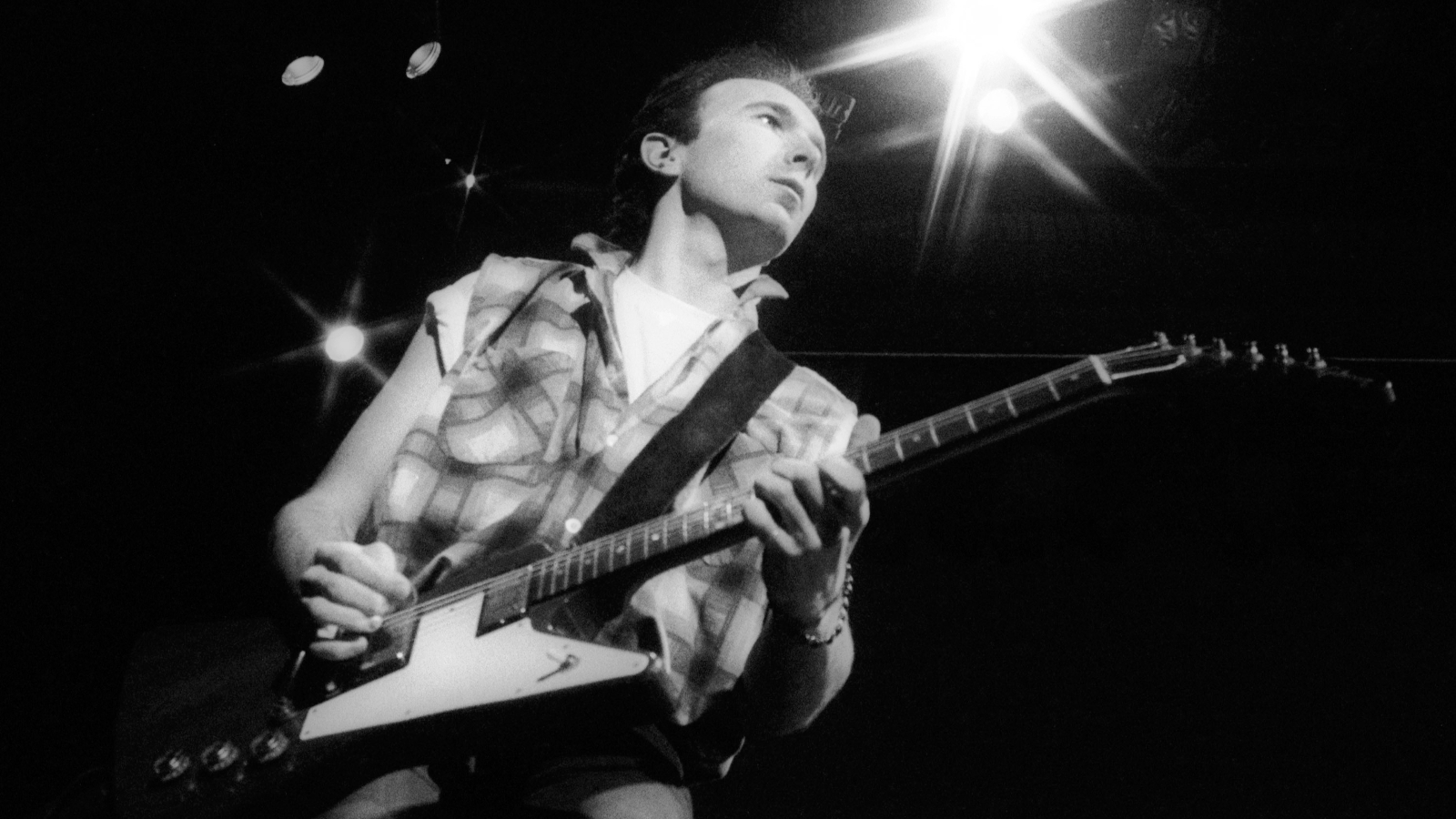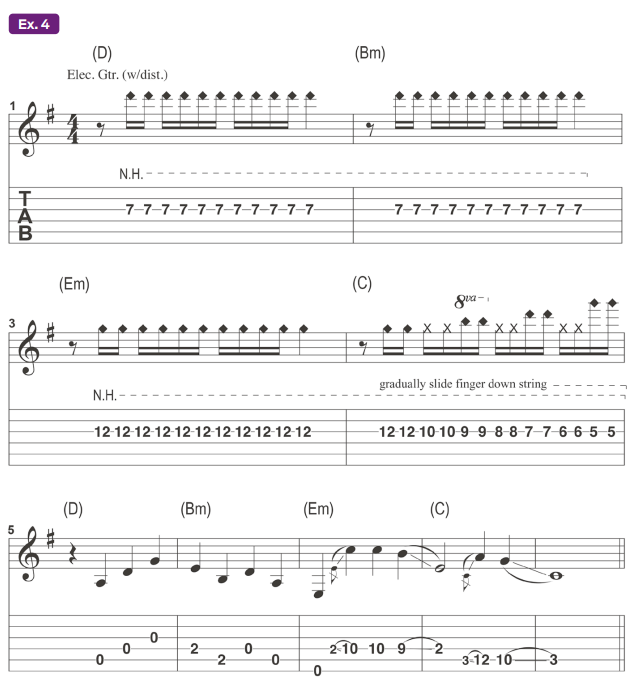Master the Edge’s Stylistic Moves From U2’s Landmark 1983 Album, ‘War’
At the heart of U2’s musical odyssey, there’s always been the inspired guitar wizardry of The Edge

It’s May 30th, 1983 and U2 lead singer Bono is addressing a crowd of several hundred thousand at the US Festival in San Bernardino, California. “When we first arrived in your country, I tried to explain that we’re not just another English fashion band passing through. We’re an Irish band and we plan on being here for a long time.”
U2 are not the headliners that day, but their electrifying set, which concludes with Bono’s perilous climb up the scaffolding while waving a white flag in a symbolic attempt to embrace the massive audience, proves his words are not a hollow boast.
The quartet, which also includes drummer Larry Mullen Jr., bassist Adam Clayton and guitarist Dave Evans (known professionally as The Edge), are touring in support of their third album, War, and while radio is starting to embrace their earnest melodic rock anthems, it’s their passionate live shows that’s making a deep connection with fans.
Just days after their US Festival triumph, the band take a risk deciding to proceed with the filming of their concert at the picturesque Red Rocks amphitheater during a driving rainstorm. The resulting footage is nothing short of magic, with the band and the crowd reaching an almost otherworldly level of intensity.
When impassioned live clips of “Sunday Bloody Sunday” and “New Year’s Day” go into heavy rotation on MTV, U2 quickly become one of the biggest, most recognizable bands on the planet. And while Bono’s soaring tenor voice and evangelical stage manner are the face of U2, it’s the unassuming stoic-faced guitarist to his right that’s the band’s secret weapon.
Eschewing traditional blues-based rock, metal pyrotechnics and folky strumming, The Edge created a detailed yet minimalist guitar approach using open-string drones, harmonically ambiguous high-string voicings, natural harmonics, delay-generated atmospherics and single-note echo repeats.
Coupled with Mullen’s muscular pattern-based drumming and Clayton’s funky, harmonically-centered bass lines, The Edge’s guitar work gave the band a unique, spacious sound that was greater than the sum of its parts.
All the latest guitar news, interviews, lessons, reviews, deals and more, direct to your inbox!
To celebrate the 40th Anniversary of U2’s breakthrough album and tour, let’s take a dive into some of the game-changing licks that made them a household name and distinguished The Edge as a key player in the guitar landscape of the ’80s and beyond.
Before we begin, we’ll go over a few performance notes. The Edge makes effective use of a German-made pick called a Herdim by flipping it around and striking the strings with the bumpy grip end. This provides a raspy percussive attack and is a key factor in his sound. Although not necessary, if you want to experiment with the Herdim pick, they are available online. Also, for our recorded examples I’ve put a bar of drums up front to help establish the groove.
Around the time U2 recorded War, The Edge relied heavily on his 1976 Gibson Explorer, a '70s Stratocaster and a 1964 Vox AC30 Top Boost amp. An Electro-Harmonix Memory Man analog delay was a major part of his sound on the band’s first two albums, although on War he made a conscious effort to rely less on it.
At the beginning of the tour however, he added a rack-mounted Korg SDD-3000 digital delay (skewing the input and output attenuators for additional drive), and its pristine clarity, atmospheric modulation, and rhythmic repeats would feature prominently on live recordings and future albums.

The first four bars of Ex. 1 are based on the austere top-string arpeggio riff of U2’s breakthrough hit, “Sunday Bloody Sunday.”
Anchor your middle finger on the B string’s 3rd fret; this will allow you to play the D chord by barring your index finger across the top three strings. Notice how the bass notes provide the foundation of the overall implied harmonic structure and chord movement (indicated in parentheses).
The Edge would use a variation of this riff (without the top-string F#) on the 1984 live arrangement of the song “A Sort of Homecoming,” and the rhythm transcribed here is closer to that pattern.
The example’s second half highlights another feature of The Edge’s early ’80s playing – the use of natural harmonics (N.H.) as melodic and harmonic devices.
Notice that their high-register chime over the bass notes creates an open airiness in the music, ensuring that the F# harmonic doesn’t sound dissonant when pitted against Clayton’s F bass note.

Ex. 2 is based on the truculent solo break in “Sunday Bloody Sunday.” Like the original, it conjures bagpipes with linear movement up and down the top two strings against open-string drones before segueing into militant, muted-string march rhythms in the final two bars.
According to his autobiography, Surrender, the first thing Bono ever heard a teenage Edge play on guitar was a Yes song with harmonics and fancy finger-picking.
The Edge most likely had his ear open to the playing of Yes guitarist Steve Howe because, like Howe, he sometimes used an overdriven echo-drenched lap steel (a 1945 Epiphone) to color certain sections of songs.
At other times, The Edge would use slide in an emotive, textural way that was more about orchestration than parroting all-too-familiar blues licks.

Ex. 3 is a slide riff similar to the guitar line between the verses in “The Refugee.” Play it with some added fuzz and a tremolo effect to cop the vibe.

Toward the end of 1983, U2 released the eight-song live EP Under a Blood Red Sky, cementing their reputation as a must-see live band. Ex. 4 is based on that album’s version of “New Year’s Day.”
In concert, The Edge would switch between a melodic piano figure and textural guitar sound washes like the harmonic stabs in the first four bars of our example.
In bar 4, start with a 12th-fret harmonic on the G string, then gradually but evenly slide the fret-hand finger down to the harmonic at the 5th fret while picking continuous 16th notes and keeping the same light touch throughout, surveying other harmonics along the way.
The last few bars of the example mirror the song’s dramatic guitar break, by making effective use of open strings and linear slides. Like The Edge’s live performances of the song, I’ve added a quarter-note rhythmic delay at 460ms and a wet/dry mix of 40/60 here.

Despite U2’s penchant for ethereal soundscapes and emotionally-charged anthems, the band could also deliver funky dance-floor inspired grooves. Ex. 5 is based on an example of this, from the song “Two Hearts Beat as One.”
In the first four bars of that song, The Edge plays a driving single-note figure on the G string, making it pop rhythmically by using idle fret-hand fingers to mute the strings next to the fretted note and incorporating the dampened “scratch” sound into his picking, which is actually strumming.
You can accomplish this tricky fretboard move by grabbing the fretted note on the G string with your 2nd finger and dampening the adjacent D and B strings behind it with your 1st finger. Or you can simply fret the note with your 1st finger and angle it in a way that it makes enough contact with the neighboring strings to deaden them.
The second half of the exercise utilizes another Edge go-to grip – the root-5th-octave power chord starting from a D-string root. These high-voiced chords sound chime-y and open compared to the dark heaviness of lower-string voicings.


Our final tribute, Ex. 6 is inspired by the riffs and general harmonic approach of the songs “Surrender” and “Red Light” and shows how The Edge could enliven a simple two-chord groove through the use of judicious chord shapes and harmonic choices.
Notice how open low E notes here alternate with a root-3rd dyad (E-G#), followed by A, D, and F# natural harmonics, which more intricately flesh out an implied E-to-D progression in the first two bars.
The same two chords seem to have much more harmonic movement when spelled out as ascending two-note voicings in bars 3-10. To give the example a little more bounce, I’ve added a dotted-eighth-note delay, at 390ms and a wet/ dry mix of 40/60.

1983 was certainly a breakthrough year for U2, but it was hardly their pinnacle. The following decades would bring multiple number one albums, sold-out stadium tours, constant artistic reinvention and eventual induction into the Rock and Roll Hall of Fame.
At the heart of this storied musical odyssey, there’s always been the inspired guitar wizardry of The Edge.
